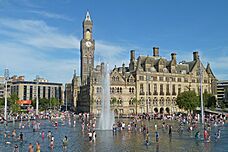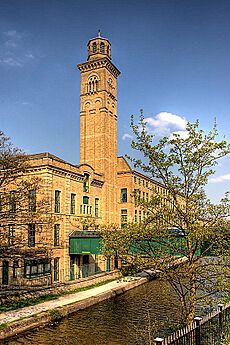City of Bradford facts for kids
Quick facts for kids
City of Bradford
|
||
|---|---|---|
| Bradford | ||
|
||
|
||
| Nickname(s):
'Wool City'
|
||
| Motto(s):
'Progress-Industry-Humanity'
|
||

Bradford shown within West Yorkshire
|
||
| Sovereign state | United Kingdom | |
| Country | England | |
| Region | Yorkshire and the Humber | |
| Ceremonial county | West Yorkshire | |
| Historic county | Yorkshire | |
| Admin HQ | Bradford | |
| Borough charter | 1847 | |
| City status | 1897 | |
| City of Bradford Met. District created | 1974 | |
| Government | ||
| • Type | Metropolitan borough, City | |
| Area | ||
| • Total | 143 sq mi (370 km2) | |
| Population
(2005 est.)
|
||
| • Total | 539,776 (Ranked 7th) | |
| • Density | 3,341/sq mi (1,290/km2) | |
| • Ethnicity (2021 census) |
|
|
| Ethnicity (2021) | ||
| • Ethnic groups |
List
|
|
| Religion (2021) | ||
| • Religion |
List
33.4% Christianity
30.5% Islam 28.2% no religion 5.5% not stated 0.9% Sikhism 0.9% Hinduism 0.4% other 0.2% Buddhism 0.1% Judaism |
|
| Time zone | UTC+0 (Greenwich Mean Time) | |
| Postcode |
BD, LS
|
|
| Area code(s) | 01274 (urban core/wider city) 01535 (Keighley) 01943 (Ilkley) |
|
| ISO 3166-2 | GB-BFD | |
| ONS code | 00CX (ONS) E08000032 (GSS) |
|
| NUTS 3 | UKE41 | |
| OS grid reference | SE164331 | |
| Website | www.bradford.gov.uk | |
| Click the map for an interactive fullscreen view | ||
Bradford (![]() i/ˈbrædfərd/), also known as the City of Bradford, is a large area in West Yorkshire, England. It is named after its biggest town, Bradford, but it also includes other towns and villages like Keighley, Shipley, Bingley, Ilkley, Haworth, Silsden, Queensbury, Thornton, and Denholme.
i/ˈbrædfərd/), also known as the City of Bradford, is a large area in West Yorkshire, England. It is named after its biggest town, Bradford, but it also includes other towns and villages like Keighley, Shipley, Bingley, Ilkley, Haworth, Silsden, Queensbury, Thornton, and Denholme.
Bradford has a population of over 528,000 people. This makes it one of the largest districts in England. It is part of a bigger urban area called the West Yorkshire Urban Area.
The city is located near the Pennines mountains. To the east, it borders the City of Leeds. To the south, it is next to Kirklees, and to the southwest, Calderdale. The area is very green, with lots of open spaces, valleys, and moorlands. The Yorkshire Dales and the Peak District are also close by.
Bradford is famous for its beautiful old buildings, many made from local stone. There are over 5,800 listed buildings and 59 special conservation areas. The village of Saltaire is so special that it is a UNESCO World Heritage Site.
In the 1800s, Bradford became a very important place for making textiles, especially wool. It had easy access to coal, iron, and water, which helped its factories grow. This led to a huge increase in population and new buildings.
Today, Bradford still has a strong economy. While wool and textiles are still important, new and growing industries include information technology, financial services, digital businesses, and tourism. Bradford was chosen as the UK City of Culture for 2025.
Bradford has welcomed many people from other countries over the years. In the 1800s, many people came from Ireland and Germany. In the 1950s, many arrived from South Asia and Poland. This mix of cultures makes Bradford a very diverse place.
Contents
A Look at Bradford's Past
Bradford became a municipal borough in 1847. This meant it had its own local government. It was given the special title of "city" in 1897. Over the years, Bradford grew bigger by including nearby towns and villages.
The famous Brontë sisters, Emily, Anne, and Charlotte, were born in Thornton, which is now part of Bradford. They later moved to Haworth and wrote classic books like "Wuthering Heights" and "Jane Eyre."
Bradford also played a key role in the early days of the Labour Party. A mural in Little Germany celebrates the founding of the Independent Labour Party in Bradford in 1893.
Bradford's Role in World War I
During World War I, many young men from Bradford joined special army groups called "Pals battalions." These were the 16th, 18th, and 20th Battalions of The Prince of Wales's Own West Yorkshire Regiment.
On July 1, 1916, a sad day during the Battle of the Somme, many of these soldiers were killed or injured. Out of about 1,394 men from Bradford who went into battle, 1,094 were lost. Other Bradford battalions also fought bravely in the war.
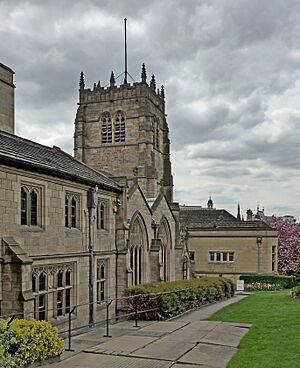
In 1919, the Church of Saint Peter became Bradford Cathedral. This made it the main church for the area.
Modern Bradford's Development
The current city boundaries were set in 1974. This is when the old County Borough of Bradford joined with other towns and districts.
The National Science and Media Museum opened in Bradford in 1983. It was built on the site of an old music hall where one of the first cinema shows outside London took place. Today, the museum hosts the annual Widescreen Weekend film festival.
In the early 2000s, Bradford worked to improve its city centre. Money was invested to build new homes, leisure places, and a banqueting hall.
In December 2001, Saltaire was named a World Heritage Site by UNESCO. This means it is a very important place that needs to be protected. The village, including Salts Mill, is still very well preserved.
In October 2007, Bradford was named the greenest city in the UK. This was because it had the lowest environmental impact of any British city. Even though it was a big part of the Industrial Revolution, Bradford's rivers are clean, and the city has many green spaces and recycling programs.
Bradford became the world's first UNESCO City of Film in 2009. This title recognizes Bradford's long history with film and its efforts to use film for cultural growth and community building. Bradford has been a film location since the early days of cinema.
Recently, in April 2021, parts of Little Germany were used to film scenes for the TV show All Creatures Great and Small.
Bradford's Landscape and Rivers
The City of Bradford is located on the edge of the Pennines. It shares borders with Leeds, Kirklees, Calderdale, Pendle, Craven, and Harrogate.
Bradford has a lot of natural beauty. About two-thirds of the district is countryside. It has 3,636 hectares of moorland, including Ilkley Moor, where the land rises to 402 meters (1,319 feet) above sea level. Over half of Bradford's land is green open space.
Three river systems flow through the City of Bradford. The River Aire runs through towns like Keighley, Bingley, and Shipley. The River Wharfe flows through Ilkley. Smaller rivers that feed into the River Calder also pass through the district. Interestingly, Bradford itself is not built on a large river. Its name comes from a "broad ford" (a shallow crossing) over the Bradford Beck stream.
Local Parishes and Villages
While much of Bradford is managed directly by the city council, many of the smaller towns and villages have their own local councils. These include:
- Addingham
- Baildon
- Burley
- Clayton
- Cullingworth
- Denholme
- Harden
- Haworth, Cross Roads and Stanbury
- Ilkley
- Keighley
- Menston
- Oxenhope
- Sandy Lane
- Silsden
- Steeton with Eastburn
- Trident
- Wilsden
- Wrose
How Bradford is Governed
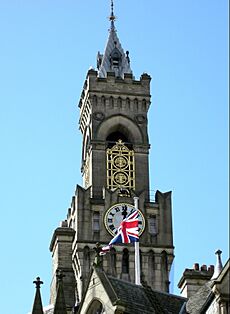
Bradford is governed by the City of Bradford Metropolitan District Council. This council was created in 1974 when several smaller areas joined together. The council is based at Bradford City Hall.
Local Representatives
People in Bradford are represented in the British Parliament by Members of Parliament (MPs). There are five MPs for the Bradford area, representing different parts of the district.
The city is divided into 30 areas called "wards." Each ward elects three Councillors to the city council. Elections are held every May, and one-third of the 90 seats are up for election each time.
| Party | Seats 2016 | Current Council (2016) | ||||||||||||||||||||||||||||||||||||||||||||||||||||||||||||||||||||||||||||||||||||||||||
|---|---|---|---|---|---|---|---|---|---|---|---|---|---|---|---|---|---|---|---|---|---|---|---|---|---|---|---|---|---|---|---|---|---|---|---|---|---|---|---|---|---|---|---|---|---|---|---|---|---|---|---|---|---|---|---|---|---|---|---|---|---|---|---|---|---|---|---|---|---|---|---|---|---|---|---|---|---|---|---|---|---|---|---|---|---|---|---|---|---|---|---|---|
| Labour | 49 | |||||||||||||||||||||||||||||||||||||||||||||||||||||||||||||||||||||||||||||||||||||||||||
| Conservative | 21 | |||||||||||||||||||||||||||||||||||||||||||||||||||||||||||||||||||||||||||||||||||||||||||
| Lib Dems | 10 | |||||||||||||||||||||||||||||||||||||||||||||||||||||||||||||||||||||||||||||||||||||||||||
| Greens | 3 | |||||||||||||||||||||||||||||||||||||||||||||||||||||||||||||||||||||||||||||||||||||||||||
| Independent | 3 | |||||||||||||||||||||||||||||||||||||||||||||||||||||||||||||||||||||||||||||||||||||||||||
| The Independents | 2 | |||||||||||||||||||||||||||||||||||||||||||||||||||||||||||||||||||||||||||||||||||||||||||
| Queensbury Independents | 2 | |||||||||||||||||||||||||||||||||||||||||||||||||||||||||||||||||||||||||||||||||||||||||||
Bradford's Coat of Arms
The coat of arms for Bradford City Council has special symbols. The boar's head comes from an old story about a wild boar that caused trouble in Cliffe Wood. The stag and the white angora goat represent the wider district and its history in the wool industry. The roses on the collars stand for the Yorkshire rose. The motto, 'LABOR OMNIA VINCIT', means "Work conquers all."
Bradford's Population and People
In 2021, the City of Bradford had a population of 528,155 people. The population density was about 1,290 people per square kilometer (3,341 per square mile).
Bradford is a very diverse place. According to the 2021 census:
- 61.1% of the population was White.
- 32.1% was Asian.
- 2.7% was Mixed ethnicity.
- 2% was Black.
- 2% belonged to other ethnic groups.
Bradford has a younger population compared to the average for Yorkshire and England.
Fun Things to Do in Bradford
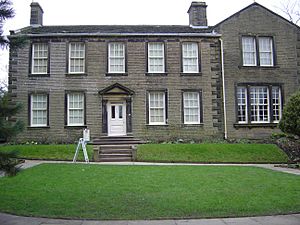
Brontë Country is a beautiful area that includes parts of Bradford, like Haworth, where the Brontë sisters lived.
Some of the main attractions that bring visitors to Bradford include:
- The Keighley and Worth Valley Railway
- Ilkley's Cow and Calf Rocks
- Bradford's National Science and Media Museum
- Bradford City Park
- Cartwright Hall
- Saltaire village, a UNESCO World Heritage Site
- Salts Mill
Bradford is also known as the world's first UNESCO City of Film.
Many exciting events happen in Bradford throughout the year, such as:
- The Bradford Literature Festival
- The Bradford Film Festival
- The Bradford Festival
- The Bradford Mela
- Bingley Music Live
- The Ilkley Literature Festival
- Haworth's 1940s weekend
- The Saltaire Festival
Tourism is a big part of Bradford's economy, bringing in over £500 million each year and supporting more than 13,500 jobs.
-
National Science and Media Museum in Bradford, the world's first UNESCO City of Film
Bradford's Economy and Jobs
Bradford's economy is worth about £9.5 billion. It contributes a lot to the Yorkshire and the Humber region. In the past, it was famous for its wool and textile industries. Today, manufacturing still provides about 1 in 5 jobs.
The service sector, which includes jobs like information technology, financial services, tourism, and retail, makes up 77% of the district's 195,000 jobs. Many big companies, like Morrisons and Hallmark Cards, have their headquarters here. Three of the UK's largest financial companies are also based in Bradford: Yorkshire Building Society, Santander Group, and Vanquis Banking Group.
Bradford's population has been growing faster than many other UK cities. The city also has a younger population on average. Experts have named Bradford as one of the top cities in the UK ready for future growth.
Learning in Bradford
Bradford has many schools and colleges for education. The local council manages state schools. There are also independent (private) schools like Bradford Grammar School. For older students, Bradford College and the University of Bradford offer further and higher education.
Media and News
Television and Radio
For television, people in Bradford watch BBC Yorkshire and ITV Yorkshire, which broadcast from nearby Leeds.
Local radio stations include:
- BBC Radio Leeds
- Heart Yorkshire
- Capital Yorkshire
- Hits Radio West Yorkshire
- Greatest Hits Radio West Yorkshire
- Sunrise Radio (for the Asian community)
- BCB 106.6fm
- Drystone Radio (covering Wharfedale)
Newspapers
Local newspapers for the area are:
- Telegraph & Argus
- The Yorkshire Post
- Yorkshire Evening Post
Getting Around Bradford
Public Transport
Metro helps organize public transport in Bradford. Most local train services are run by Northern. You can also take longer-distance trains to London King's Cross railway station from Bradford Interchange and Bradford Forster Square station.
Train lines connect Bradford to many places:
- The Wharfedale line goes to Ilkley, Burley-in-Wharfedale, and Shipley.
- The Airedale line connects to Skipton, Keighley, Bingley, and Saltaire.
- Both Bradford Forster Square and Bradford Interchange have direct routes to Leeds, York, and Hull.
- Bradford Interchange also connects to Manchester, Halifax, and London King's Cross.
There are bus stations in Bradford, Ilkley, Keighley, and Shipley.
Air and Water Travel
Leeds Bradford Airport is about 10 kilometers (6 miles) northeast of the city centre. It has flights to many places in Europe, the United States, and other countries.
The Leeds and Liverpool Canal runs through the district. The Five Rise Locks at Bingley are a famous example of canal engineering. There are also plans to reopen the Bradford Canal, which closed in 1922.
Roads and Motorways
The M606 motorway connects Bradford to the national motorway network. It is one of the shortest motorways in the country. The A650 road has been improved to a dual carriageway, bypassing towns like Bingley and Keighley.
Bradford's Twin Towns
The City of Bradford has special "Twin Town" or "Sister City" agreements with several communities around the world. This helps build friendships and cultural exchange.
| Country | Place | Originally twinned with | Date |
|---|---|---|---|
| Belgium | Verviers | Bradford | 1970 |
| France | Coutances | Ilkley | 1969 |
| France | Eppeville | Wilsden | 1982 |
| France | Poix-du-Nord | Keighley | 1919 |
| France | Roubaix | Bradford | 1969 |
| Germany | Hamm | Shipley | 1976 |
| Germany | Mönchengladbach | Bradford | 1971 |
| Ireland | Galway | Bradford | 1987 |
| Macedonia | Skopje | Bradford | 1963 |
| Pakistan | Mirpur | Bradford | 1998 |
| Peru | Machu Picchu | Haworth | 2005 |
| United States | Haworth | Haworth | 2004 |
| United States | Myrtle Beach | Keighley | 1993 |
See also
 In Spanish: Ciudad de Bradford para niños
In Spanish: Ciudad de Bradford para niños
- Bradford District Museums & Galleries
- List of people from Bradford
- Grade I listed buildings in City of Bradford
- List of Pals battalions
- Listed buildings in Bradford
- Timeline of Bradford history


